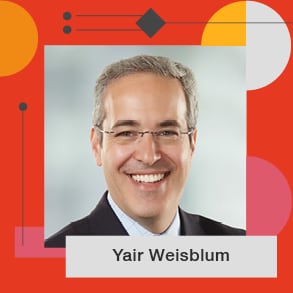
In this two-part Transformation Talks episode, PwC Canada’s Santanu Pal and Yair Weisblum explore business opportunities in data analytics for Canadian banks in 2023. Join them as they discuss the role of cloud investments in enabling innovation and key steps to unlock the most value from your data and create powerful business outcomes.

Part 1: New opportunities amid a fresh wave of innovation
A top priority for Canadian banks this year is investing in advanced technologies like data analytics and artificial intelligence. In part 1 of this episode, Santanu and Yair discuss the latest wave of innovations disrupting the industry, like generative AI, and the resulting business opportunities emerging for Canadian banks.
Yair: A top priority for Canadian banks is in investing in advanced technologies like data and analytics and artificial intelligence. What can banks do to stay ahead of these trends? With us today is Santanu Pal, welcome Santanu.
Santanu Pal: Thanks Yair. I'm happy to be here.
Yair: To start things off what's new in the area of data and analytics and artificial intelligence in Canadian banking?
Santanu Pal: We are seeing a lot of innovation in this space and these innovations can be very disruptive to the banks. Chat Gpt or Generative AI is the latest of these innovations. I think there are many direct applications of Chat Gpt in the banks, but what is more interesting for me is the underlying capabilities or technology that enable Chat Gpt, that can actually transform banks in how they look at their risk modeling, how they become more personalized to their clients.
There is so much that is happening here. I think as the banks go through this journey and make these investments, what is very important is they take a business lens at looking at this and they make sure that the investments that they're putting in are driving the right financial outcomes.
Yair: And banks have been investing and talking about data analytics for quite a bit of time now. What do you think are the business opportunity for them in this space?
Santanu Pal: So traditionally what we have seen is the banks are focused on data analytics and AI primarily to protect themselves. They have used data for credit risk, for really using fraud protection and even in terms of balance sheet management and cyber security. I think there is an opportunity to now use data analytics and AI to really grow their business, to really come up with new products to come up with better services and provide that more personalized experiences to their clients. One of the emerging trends that we are seeing in this space is leveraging third party data and combining it with their first party data to really provide that much more insightful client experiences that can really lead to a much better product.
The second thing that we are also seeing in terms of trends is the change in the clients and the government's expectations around privacy. There's been new regulations that have come up in Quebec in terms of privacy protection. There's a bill in the federal government as well around the same topic. Banks need to really double down on their data management capabilities. They need to really be able to meet the new expectations that the both their clients and their regulators have around data and really be able to showcase to them that they understand their data and are protecting their privacy.
I think the last thing that I would leave you with on this topic is, especially in the current environment, there is a lot of things that you can do with data around improving business efficiency. How do you cut costs in a way that actually enables growth but improves your efficiency? Digitization, automation is some of the things that AI and data can actually enable.
Yair: You mentioned like the investment in data and analytics and in data governance. The banks also are making big investments in cloud. What is your perspective on how cloud investments affect data and analytics and especially AI?
Santanu Pal: I think simply put Chat Gpt would not be possible if we want to develop it in the current bank infrastructure. Cloud enables Chat Gpt, so the underlying capabilities that cloud provides in terms of big data, large compute, and being able to build very large AI models is at the core of the value that we are seeing with some of these innovations that the banks want to leverage.
So in putting it in a very simple terms, cloud is enabling AI, and that's what in my mind, banks need to leverage. Banks are in this journey right now in moving their data to the cloud, and I'm really interested in seeing what are some of the use cases that they come up with. Some of the use cases will be very traditional in terms of better credit models, more personalized journeys, but there may be other innovative use cases that we not even think about today.
Part 2: Maximizing value with the right strategy
In part 2, Santanu and Yair dive deeper into data strategy, including the need to look beyond technology and take a broader approach to successfully implement change across the bank. Learn how to stay ahead of the trends and increase the impact of your investments.
Yair: You talked a little bit about business outcomes, protect the bank, grow the bank obviously become more efficient. Wondering if you have any perspective on what some of the execution capabilities or some of the levers they need to pull in order to get those business outcomes.
Santanu Pal: I think there are four things that I want to outline. I think it's time that the CEOs of every bank make data of a CEO priority. It should be a priority for the business leaders and the CEO. I think once that they have that priority, they then need to sit down and really develop a data strategy that is aligned to their business and is more end to end and robust.
Once they have a robust data strategy, I think the next thing they need to focus on is their talent. Really hire for the right talent, who are data driven. They are also need to hire talent, which are going to making data driven decisions.
I think the last thing they also need to focus on as they go through this journey is create abilities to deploy those insights that they have, both with people and also in terms of the processes that they have. I think once they do these four things really well, they will be able to see the value of the data that they have.
Yair: Data strategy is not a new term. People, banks have been doing it for quite a number of years. What do you think are kind of the secret sauce to actually extract more value from that?
Santanu Pal: Your data strategy is an enabler for your business strategy. It doesn't sit by itself. You need to be very clear as to how your data strategy or how your data analytics and AI is enabling your business outcomes. I think if that alignment is strong and the banks are putting in a lot of effort in creating that alignment, they will see value. I think once they do that, is really identify business value streams or how are they going to get value from the data that they have, and being very clear about that is critical in any good data strategy.
I think the third thing, what they need to do is enable action through insights. I think a lot of times I find organizations are insight rich, but action poor. This needs to happen across the organization, it needs to happen at the CEO level, at the business leaders level, but it also needs to happen in the frontline and in the back offices. As people are doing their jobs, there needs to be a way that they're being empowered with data and they can make better decisions using data. If every part of the organization is making better decisions using data, they are then a data driven organization.
And the last thing that I would leave you with is KPIs. Really being able to measure the success of the data investments that they're making and how well they're doing with data will enable business leaders to feel comfortable that their investments they're making is driving the right business outcomes and having that measure of success is critical for them to make even larger investments in data.
Yair: In those data driven organizations and they think more strategically about their data. What else do they need to do? What are some of the other items that they need to think through as they go on this journey?
Santanu Pal: If you are a data driven organization, you're making decisions based on data and you don't have good data, you will be making wrong decisions and it can pose a huge risk to your organization. I think investing in data management, investing in data quality is critical for banks to really do well around data. I think the second thing is around training and up skilling your staff around data literacy and really providing them with the training opportunities to really be relevant and understand some of the changes that are happening. This space is important. There's a lot of change happening here. It's important that their staff is skilled and understands how things are happening in the space of data.
When you think about the talent that they have in the banks today, most of the staff is actually using their time to do very operational tasks. I think banks need to go back and look at their operating model and really ask the question, can they use automation or outsourcing to do some of these mundane tasks and focus their talent on really strategic activities.
Yair: That's great. I think these are really great insights about how to make it real and make it tangible. So before we wrap up, any final thoughts on this domain?
Santanu Pal: I think one of the things about data is speed matters. What you'll find with most of the banks is their data processes are either driven by a monthly or sometimes even quarterly processes, so that by the time they get their data, it's actually a bit too late to drive any business value through it. We call this concept data latency. So banks need to really focus on reducing data latency in their organization. There's been a lot of technology innovation that really makes real-time data very, very real today. So really moving towards more real-time or near real-time data will make their data that much more valuable to their organization, and that's another investment that the banks need to make.
Yair: Thanks so much for joining us today. I think you provided a great holistic overview of what banks are facing when it comes to data analytics and AI in 2023. And thank you audience for joining us on this Transformation Talks episode. If you do have any questions on data analytics, AI, please don't hesitate to reach us here at PWC.
“I think there is an opportunity to now use data analytics and AI to really grow their business, to really come up with new products … and provide that more personalized experience to their clients."
About the speakers

Santanu Pal is a Partner at PwC Canada in our financial services consulting practice, specializing in data, analytics and AI. He has more than 25 years of experience supporting financial services organizations with their AI and data journeys, helping them create the right outcomes from advanced data engineering, analytics and data science techniques.

Yair Weisblum is a Partner in PwC Canada’s financial services consulting and deals practice. He brings more than 15 years of experience, working with a variety of organizations on issues including digital strategy, information management, commercial and retail banking and process design.
Contact us

Banking and Capital Markets, Lead Relationship Partner, PwC Canada
Tel: +1 416 941 8311

Partner and Financial Services Data, Analytics and AI leader, PwC Canada
Tel: +1 905 418 3448





















